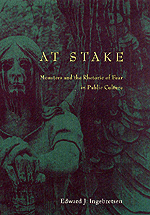 |
 |
 |
 |
 |
![]()
Volume 5,
Issue 3, Spring 2002
|
At
Stake: Monsters and the University of Chicago Press, 2001 341 pages Cloth: $40.00 US |

|
Reviewed by: Molly
Swiger, Prairie View A&M University
Printer-friendly PDF
version
Edward J. Ingebretsen’s At Stake: Monsters and the Rhetoric of Fear in Public Culture is a thought-provoking work of cultural criticism, drawing on psychoanalysis, sociology, and literary studies to explore the construction of monstrousness within popular culture.
Ingebretsen discusses the history of the term "monster" to the present. In pre-Christian times, the monster was a child born with physical abnormalities. These "monster-children" indicated an omen from the gods and signaled that the populace was doing something wrong. Similarly, Ingebretsen argues, monsters today are encircled with prophetic rhetoric that is now an essential part of American civic pedagogy.
The book examines closely the construction of five modern-day monsters. Chapters Two and Three inspect the media coverage of serial killers Jeffrey Dahmer and Andrew Cunanan respectively. Both Dahmer and Cunanan were labeled as homosexuals by the media. For example, Cunanan, who is alleged to have killed five persons, including Gianni Versace, was said to be sexually promiscuous, shop extravagantly, and dress like a woman. Ingebretsen argues that Andrew Cunanan reprises fears of gender failure, and situated homosexuality with perversity.
These monsters escape classification; monsters and their crimes are often deemed indescribable. "Invariably, the term ‘monster’ is always ‘want for a better word,’ since neither language nor social permission extends where that word wants to take us" (p. 45). The failure of speech, argues Ingebretsen, signals that the humanity of the monster is erased, thereby erasing the closeness they are to us. Once deemed inhuman, violence is not far off. As monsters who threatened the "norm" with their sexuality, they had to die. Both Dahmer and Cunanan died violently; Dahmer in prison, and Cunanan by his own hand.
In Chapter Four Ingebretsen asks why Susan Smith, a mother who killed her children, was elevated to monster, while other child-killing parents are not. Ingebretsen explains that the narrative surrounding Smith, like that of Cunanan, portrayed a threat to domesticity. Cunanan invaded homes, while Smith violated her identity as a mother. When women are portrayed as monsters, it is because they threaten the sanctity of domesticity. Her betrayal of motherhood, Ingebretsen argues, ultimately became a betrayal of the country as it was used as a conservative political omen signifying the breakdown of "family values."
Ingebretsen discusses the Bill Clinton-Monica Lewinsky scandal in Chapter Five. Like the media coverage of Smith, the scandal was engineered by conservative political forces to signify something about U.S. society. Both Smith and Clinton were important not as individuals, but in their role as protagonists in a narrative of communal identity. Like the "abnormal" babies of the past, they were used to signal society’s moral downfall.
In the final chapter of his book, Ingebretsen considers the discursive images at play after the homophobic murder of Mathew Shepard. The homosexual, Shepard, was transfigured as Christ. His "body was found strapped ‘scare-crow like’ to a split-rail fence . . ." (p. 178). Outside the church in which his funeral was conducted, a group of mourners used wings made of sheets and called themselves the "Angel Action." Although Shepard’s fatal beating was associated with Christ’s crucifixion, this representation is also monster-rhetoric because, Ingebretsen maintains, Jesus was a monster too.
Ingebretsen repeatedly reveals the conventional ways in which the mass media’s portrayal of each "monster" carries out the ideological work of sexism, racism, and homophobia. Furthermore, he demonstrates that monster-making and destruction follow a ritualistic and predictable genre formula: (1) The monster, either discovered or created, is identified; (2) the monster publicly analyzed; and (3) the monster is staked. In this process, Ingebretsen argues that monsters are made visible in order to warn. The monster, and his or her "abnormalities," shows us by inversion what normal is, or should be. In other words, the monster is the "abnormal" that helps define the "normal." They are, by example, pedagogical tools that help ensure that readers will not be like them. With significant skill, Ingebretsen reveals that monsters are the agents of ideology, and monster-making is a kind of rhetorical discipline, meant to teach and to punish.
Back to Top
Home | Current
Issue | Archives
| Editorial Information
| Search | Interact